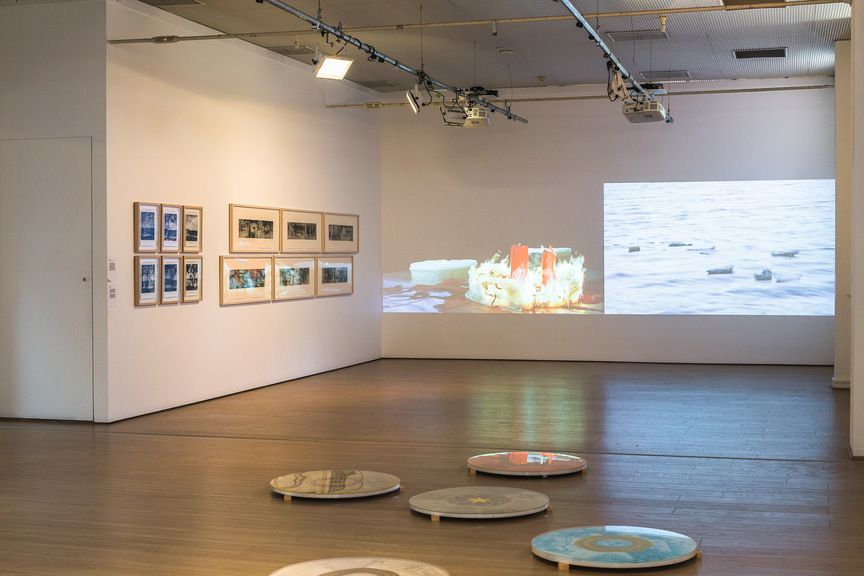-
From Current Issue
-
- Editor’s Letter Fire in the Heart
- Reviews I Gusti Ayu Kadek Murniasih
- Reviews 11th Seoul Mediacity Biennale: “One Escape at a Time”
- Dispatch Networked China
- One on One Monira Al Qadiri on Yukio Mishima
- Essays The rise of independent art spaces in pandemic-era Shanghai
- Features Tuan Andrew Nguyen
- Table of Contents
- Web Exclusives
- Archive
- Subscribe

R
E
V N
E
X
T
Like melting wax that slowly drips, so do memories gradually change shape, their content reassembling into a more abstract form which still contains the essence of the original. In Dacchi Dang’s work Et in Arcadia Ego (2017), a number of cast wax cross sections of bamboo trunks hang like wind chimes above a bed of slowly drying bamboo foliage, the leaves softly crunching underfoot as the viewer moves around the installation. Embedded in the interiors of these wax pendulums are small hand-printed photographs of Saigon captured by Dang on his first return to Vietnam in 1994 after fleeing in 1982, and scenes of Hanoi taken in early 2017 by the artist on his first visit to the country’s north. In a series of performances during the course of the exhibition, this wax forest is melted bit by bit. It is a powerful work which harnesses the universal experiences of uprootedness and volatility known to diasporic communities, as well as conjuring the more specific effects of war sustained by Dang’s original homeland.
Et in Arcadia Ego is a new work commissioned by 4A Centre for Contemporary Australian Art for Dang’s survey exhibition “An Omen Near and Far.” Dang is a founding artist member of 4A, which was established in 1997, and the exhibition spans three and a half decades of the Vietnamese-Australian artist’s practice, including photographic documentation of the precursor to Et in Arcadia Ego, the 1994 exhibition “Upstairs/Downstairs.” While Dang has used installation, video and printmaking in his work, “An Omen Near and Far” shows photography to be a conceptually core component of the artist’s practice, which examines the shifting nature of identity and home for members of diaspora.
DACCHI DANG, Certificate of Commendation, 1982, ink and watercolor on paper, stamped official document from Pulau Bidong Refugee Camp in Malaysia, 22.8 × 32 cm. Photo by Document Photography. Courtesy the artist.
Dang, the child of a Chinese father and Vietnamese mother, has been replicating memories from his earliest moments as an artist. At the symbolic heart of the show is Certificate of Commendation (1982), a certificate acknowledging Dang’s contribution as an art teacher in the Malaysian refugee camp where he resided for nine months during his mid-adolescence. Dang, unsatisfied with the photocopied version he had received, re-created it in watercolour and ink and managed to have it stamped by authorities, rendering it an official document. This humble A4 sheet, framed by elaborate curlicues and watermarked with a map of the artist’s promised new homeland of Australia, is only in Dang’s possession because it was smuggled out by an official in exchange for having their portrait painted. The Malaysian authorities were reluctant for any evidence of the camp to leave its borders; the artist not only retained but also enhanced this crucial record of his past.
Dang’s residencies spent in Paris, and on Teerk Roo Ra or Peel Island off the coast of Brisbane, resulted in several works in “An Omen Near and Far” that address this notion of shifting and redefining identity. In a video work made by indigenous Dharug artist Janelle Evans, who accompanied Dang on the latter residency in 2011, Dang can be seen constructing a pinhole camera from an old leper hut. In the resulting works Essence of Land and Island Memory (both 2011) from the suite “Lens of the Other,” the island, a site of concentrated colonial dispossession, is impressed onto the photographic paper and into the eye of the viewer in a series of haunting inversions.
A group of circular works on the floor titled Liminal (2005) stem from Dang’s recognition, during a residency in Paris in 2003, of that city’s architectural influences on Saigon. Incorporating motifs from northern Vietnamese drums which were stolen for display in Parisian museums, and recalling the circular footprint of Saigon’s food market, the artist has reimagined and reclaimed this architectural legacy. Like the other works in “An Omen Near and Far,” the work acknowledges the volatility of culture and of memory, devised in people and in place, melted down and reforged to form identity anew.
Installation view of DACCHI DANG’s “An Omen Near and Far” at 4A Centre for Contemporary Asian Art, Sydney, 2017. (Left) Essence of Land (from the series “Lens of the Other”), 2011, pigment on photo paper, 74 × 102 cm. (Center) Island Memory (from the series “Lens of the Other”), 2011, pigment on photo paper, 74 × 102 cm. (Right) JANELLE EVANS, Dacchi Builds a Camera, 2017, documentation of Dacchi Dang at Peel Island, 2011, 16:9 DVC loop, 5 minutes. Photo by Document Photography. Courtesy the artist.
Dacchi Dang’s “An Omen Near and Far” is on view at 4A Centre for Contemporary Asian Art, Sydney, until July 30, 2017.
To read more of ArtAsiaPacific’s articles, visit our Digital Library.








